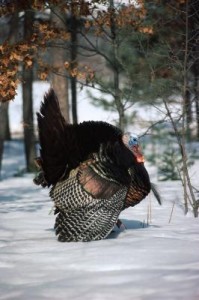Edwin Matthews· co fondateur des Amis de la Terre. March 1, 2012
The dim early morning light hardly reveals my hay field through the misty fog, but I can discern them approaching nearly in a line as if they were Hessian grenadiers in martial formation. I count eight wild turkeys (Meleagris gallopavo silvestris) often in the morning foraging when I begin my own.
Two hundred fifty years ago, when our town was first settled and local meetings gathered, there were no wild turkeys left in Northwest Connecticut. Turkeys were easy and delicious prey for the early settlers. Clearing of forests for farms and charcoal also removed the principal source of turkey food: tree nuts, tubers, leaves and insects. Severe winters in the early 1800’s helped to wipe out the few remaining birds. But although years ago humans exterminated wild turkeys from Connecticut, we recently brought them back. From 1975 to 1992, 356 wild turkeys captured elsewhere were reintroduced to our state at 18 sites. With hunting now limited and with a warmer climate, dense foliage for nesting and resurging forests for food, in a few short years these immigrants flourished and the species has recovered. Wild turkeys have once again become abundant and are now present in every Connecticut town. As I watch the squad of turkeys cross my field and approach my house, I am grateful for this bit of corrective human management of our ecosystem, as I presume the turkeys are as well.
I must be admiring of this weird appearing, but well-adapted, feathered creature: a hugely over-size flying bird perfectly designed to spend its waking days not in flight, but on the ground ceaselessly scratching and pecking the earth for food. Benjamin Franklin proposed that the turkey be designated our national bird, as he argued this industrious bird would be a more appropriate symbol of “the temper and conduct of America” than the bald eagle (Haliaetus leucocephalus), a rapacious scavenger. The wild turkey apparently lost by one vote, but turkeys care not a fig for human elections.
Three over-sized clawed toes, along with their pointed beaks, provide fierce instruments for hoeing the earth; a smaller toe behind serves for balance. Their legs are amidships. This bird is designed for constant walking, and it will spend its life in an endless trek for food. Grown turkeys walk together, yet I have noticed they maintain several wing spreads from each other, so as to be sure to cover the territory and give each a chance at an undisturbed slice of earth, but also to facilitate an aerial escape should danger strike. Their striking red and blue naked, tiny wrinkled and wattled heads bob and poke incessantly as they march. A well developed crop at base of neck stores gathered food; while they rest at night this food steadily advances to the stomach where it is digested. And although without molars, they have a powerful, grit-filled gizzard that grinds hard seeds and nuts.
At night, after their long day’s hike searching food, turkeys take to trees where they can roost and rest safe from prowlers. At daylight they descend to resume their endless march. When the ground is covered with snow, they might remain at roost for days and may choose nut trees like oaks (Querus) for food.
I once watched a lek, or assembly, of wild turkeys that had gathered in my field for a mating ritual. Several males were vainly strutting with their fan tails deployed, each deploying a fan of tail feathers trying to be more impressive than the next. Turkey males do battle for girls, but in this case what I watched was benign competitive behavior. A flock of a dozen females hung about and appeared to pay scant attention to the strutting males like a high school prom. At one point I noticed that I was not alone in watching this scene: from the edge of the field a gray fox (Urocyon cinereoargenteus) was paying close attention to the approaching flock. The fox’s stealth was insufficiently sly, however. Turkeys have much better eyesight than we do and can hear for a mile. Well aware the fox was there, the turkeys casually moved to the far side of the field. The fox then switched sides and snuck closer. Finally, the turkeys had enough of being stalked. The whole flock of 4 foot, 25 pound terrestrial birds, being birds after all, with flapping wings took to the air at 60 miles per hour, twice the speed of their intruder confined for his life to the ground. As they flew out of sight, the fox was left alone on the ground to find his next meal elsewhere, as was I.
This hazy morning, the turkey militia advances through my farm, neatly skirting the unfamiliar trees that fell in our surprise early autumn snowstorm. I see them clearly now close to the house. Their iridescent, burnt autumn polychromatic feathers are simply beautiful. They advance nobly as if, with this camouflage, they believe they cannot be seen.
When a turkey chick, called a poult, poult emerges from its egg after 25 days incubation under its mother on the ground, it will imprint immediately and follow the first gobble it hears. Precocious and able to fly in a week or two, the poult will begin early its life-long march for food. No turkey has to decide its path in life. As the turkey infantry passes under my breakfast window, bobbing and pecking at the earth, taking every seed and insect in its way, I have no small admiration for this fellow creature’s assiduous application to its life task.
And I now wonder how I must spend my day.
.
- · Edwin Matthews resides in Washington, Connecticut
